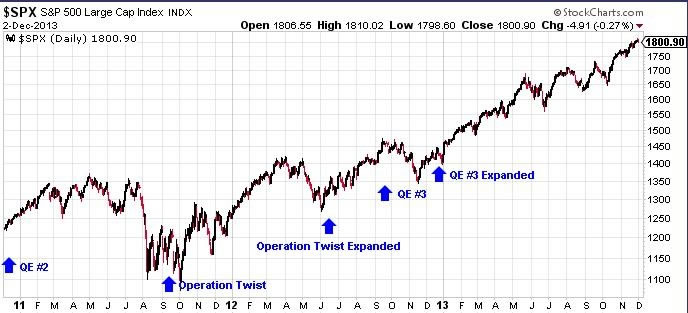The Best and Worst Investment Strategies to Battle Coming Inflation
Stock-Markets / Stock Markets 2013 Dec 09, 2013 - 05:57 PM GMT Sasha Cekerevac writes: The S&P 500 may be entering bubble-like territory: that’s what I’ve been writing for the past few months.
Sasha Cekerevac writes: The S&P 500 may be entering bubble-like territory: that’s what I’ve been writing for the past few months.
Now, it appears as though I’m not the only one who’s worried about asset classes beginning to form bubbles from the excess money printing. 2013 Nobel Prize-winner Robert Shiller also recently stated that he is concerned that prices have risen far too quickly across many asset classes, from real estate to stocks.
As I’ve written several times over the past couple of months, investing in stocks at these elevated levels is quite risky. My belief is that much of the upward move in the S&P 500has been primarily based on the liquidity (money printing) being pumped by the Federal Reserve.
Investing in stocks with this premise can only work for the very short-term trader who’s quick enough to get out when the tide begins to turn.
Because people are not investing in stocks based on actual fundamentals right now, one can’t expect the value in the S&P 500 to remain elevated once there’s a change in monetary policy, since much of the move has been artificially supported.
Let’s take a look at how the S&P 500 has been affected by monetary policy over the past few years, and how investing in stocks at the current level is becoming increasingly risky.

Chart courtesy of www.StockCharts.com
The first quantitative easing program by the Federal Reserve lasted from December 2008 until March 2010. This period is not shown on the chart above, as one could argue that the S&P 500 became extremely oversold and that investing in stocks for the long-term made sense at that point, regardless of the Federal Reserve’s policy.
The second round of quantitative easing (QE2) by the Federal Reserve began in November 2010 and lasted until June 2011. As you can see in the chart above, following the completion of the Federal Reserve’s QE2 in the summer of 2011, the S&P 500 sold off into the fall.
“Operation Twist” began during the end of September 2011 and was originally scheduled to end in June 2012. However, the Federal Reserve extended this program until the end of 2012.
And finally, we get to the third round of quantitative easing (QE3) by the Federal Reserve, which began in September of 2012 with the purchase of $40.0 billion per month of mortgage-backed securities. In December of 2012, the Federal Reserve expanded QE3 to include the purchase of $45.0 billion per month of Treasury securities.
Investing in stocks throughout this time period clearly benefited shareholders, as the Federal Reserve pumped an exorbitant amount of new money into the market. The S&P 500 continued to power higher, only selling off when each monetary policy initiative was completed.
To keep the S&P 500 moving higher, each time monetary policy was set to end, the Federal Reserve stepped in and pumped more money into the system.
I’m certainly not suggesting one should sell every single share and sit in cash only; in fact, cash is the worst investment to make during a time when the Federal Reserve is printing money like crazy, because inflation will begin to eat away at your wealth over the next decade.
What I am suggesting is that a portfolio needs to be diversified to include hedges against both a sell-off in the S&P 500 and the negative effects of money printing.
Investors may want to look at investing in stocks in sectors that still have value, while also adding precious metals, such as gold and silver, to their portfolios. Investing a small portion of your portfolio in an inverse exchange-traded fund (ETF), such as the ProShares Ultra Short S&P500 (NYSEArca/SDS), which moves up in value as the S&P 500 moves down, may also be a wise play.
This article The Best and Worst Investment Strategies to Battle Coming Inflation was originally published at Investment Contrarians
By Sasha Cekerevac, BA
www.investmentcontrarians.com
Investment Contrarians is our daily financial e-letter dedicated to helping investors make money by going against the “herd mentality.”
About Author: Sasha Cekerevac, BA Economics with Finance specialization, is a Senior Editor at Lombardi Financial. He worked for CIBC World Markets for several years before moving to a top hedge fund, with assets under management of over $1.0 billion. He has comprehensive knowledge of institutional money flow; how the big funds analyze and execute their trades in the market. With a thorough understanding of both fundamental and technical subjects, Sasha offers a roadmap into how the markets really function and what to look for as an investor. His newsletters provide an experienced perspective on what the big funds are planning and how you can profit from it. He is the editor of several of Lombardi’s popular financial newsletters, including Payload Stocks and Pump & Dump Alert. See Sasha Cekerevac Article Archives
Copyright © 2013 Investment Contrarians - All Rights Reserved Disclaimer: The above is a matter of opinion provided for general information purposes only and is not intended as investment advice. Information and analysis above are derived from sources and utilising methods believed to be reliable, but we cannot accept responsibility for any losses you may incur as a result of this analysis. Individuals should consult with their personal financial advisors.
Investment Contrarians Archive |
© 2005-2022 http://www.MarketOracle.co.uk - The Market Oracle is a FREE Daily Financial Markets Analysis & Forecasting online publication.



